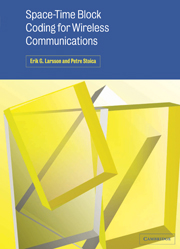
-
Select format
-
- Publisher:
- Cambridge University Press
- Publication date:
- 31 October 2009
- 08 May 2003
- ISBN:
- 9780511550065
- 9780521824569
- 9780521065337
- Dimensions:
- (247 x 174 mm)
- Weight & Pages:
- 0.788kg, 302 Pages
- Dimensions:
- (244 x 170 mm)
- Weight & Pages:
- 0.494kg, 304 Pages
You may already have access via personal or institutional login
Book description
Space-time coding is a technique that promises greatly improved performance in wireless networks by using multiple antennas at the transmitter and receiver. Space-Time Block Coding for Wireless Communications, first published in 2003, is an introduction to the theory of this technology. The authors develop the topic using a unified framework and cover a variety of topics ranging from information theory to performance analysis and space-time coding methods for both flat and frequency-selective fading multiple-antenna channels. The authors concentrate on key principles rather than specific practical applications, and present the material in a concise and accessible manner. Their treatment reviews the fundamental aspects of multiple-input, multiple-output communication theory, and guides the reader through a number of topics at the forefront of research and development. The book includes homework exercises and is aimed at graduate students and researchers working on wireless communications, as well as practitioners in the wireless industry.
Reviews
"This book will be useful for graduate students, researchers, and engineers working on wireless communications." Mathematical Reviews
Contents
Metrics
Altmetric attention score
Full text views
Full text views help Loading metrics...
Loading metrics...
* Views captured on Cambridge Core between #date#. This data will be updated every 24 hours.
Usage data cannot currently be displayed.
Accessibility standard: Unknown
Why this information is here
This section outlines the accessibility features of this content - including support for screen readers, full keyboard navigation and high-contrast display options. This may not be relevant for you.
Accessibility Information
Accessibility compliance for the PDF of this book is currently unknown and may be updated in the future.


